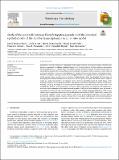Por favor, use este identificador para citar o enlazar a este item:
http://hdl.handle.net/10261/332411COMPARTIR / EXPORTAR:
 SHARE SHARE
 CORE
BASE CORE
BASE
|
|
| Visualizar otros formatos: MARC | Dublin Core | RDF | ORE | MODS | METS | DIDL | DATACITE | |

| Título: | Study of the cross-talk between Fasciola hepatica juveniles and the intestinal epithelial cells of the host by transcriptomics in an in vitro model |
Autor: | Becerro Recio, David CSIC ORCID; Serrat, Judit CSIC ORCID; López-García, Marta CSIC ORCID; Torres Valle, María CSIC ORCID; Colina, Francisco; Fernández, Iván M; González Miguel, Javier CSIC ORCID ; Siles Lucas, Mar CSIC ORCID | Palabras clave: | Differential gene expression Fasciola hepatica Intestinal epithelium Newly excysted juveniles RNA-Seq In vitro models |
Fecha de publicación: | 2023 | Editor: | Elsevier | Citación: | Veterinary Parasitology 320: 109981(2023) | Resumen: | Fasciolosis is a globally widespread trematodiasis with a major economic and veterinary impact. Therefore, this disease is responsible for millions of dollars in losses to the livestock industry, and also constitutes an emerging human health problem in endemic areas. The ubiquitous nature of Fasciola hepatica, the main causative agent, is one of the key factors for the success of fasciolosis. Accordingly, this parasite is able to subsist in a wide variety of ecosystems and hosts, thanks to the development of a plethora of strategies for adaption and immune evasion. Fasciolosis comprises a growing concern due to its high prevalence rates, together with the emergence of strains of the parasite resistant to the treatment of choice (triclabendazole). These facts highlight the importance of developing novel control measures which allow for an effective protection against the disease before F. hepatica settles in a niche inaccessible to the immune system. However, knowledge about the initial phases of the infection, including the migration mechanisms of the parasite and the early innate host response, is still scarce. Recently, our group developed an in vitro host-parasite interaction model that allowed the early events to be unveiled after the first contact between the both actors. This occurs shortly upon ingestion of F. hepatica metacercariae and the emergence of the newly excysted juveniles (FhNEJ) in the host duodenum. Here, we present a transcriptomic analysis of such model using an approach based on RNA sequencing (RNA-Seq), which reveals changes in gene expression related to proteolysis and uptake of metabolites in FhNEJ. Additionally, contact with the parasite triggered changes in host intestinal cells related to pseudogenes expression and host defence mechanisms, including immune response, among others. In sum, these results provide a better understanding of the early stages of fasciolosis at molecular level, and a pool of targets that could be used in future therapeutic strategies against the disease. | Descripción: | 9 páginas, 5 figuras | Versión del editor: | http://dx.doi.org/10.1016/j.vetpar.2023.109981 | URI: | http://hdl.handle.net/10261/332411 | DOI: | 10.1016/j.vetpar.2023.109981 | ISSN: | 0304-4017 |
| Aparece en las colecciones: | (IRNASA) Artículos |
Ficheros en este ítem:
| Fichero | Descripción | Tamaño | Formato | |
|---|---|---|---|---|
| Study of the cross-talk.pdf | Artículo principal | 5,01 MB | Adobe PDF |  Visualizar/Abrir |
CORE Recommender
Page view(s)
31
checked on 21-may-2024
Download(s)
31
checked on 21-may-2024
Google ScholarTM
Check
Altmetric
Altmetric
Este item está licenciado bajo una Licencia Creative Commons

